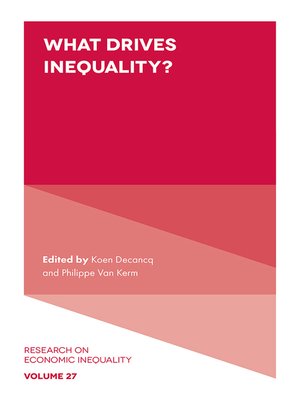Research on Economic Inequality, Volume 27
ebook ∣ What Drives Inequality? · Research on Economic Inequality
By Koen Decancq

Sign up to save your library
With an OverDrive account, you can save your favorite libraries for at-a-glance information about availability. Find out more about OverDrive accounts.
Find this title in Libby, the library reading app by OverDrive.



Search for a digital library with this title
Title found at these libraries:
| Library Name | Distance |
|---|---|
| Loading... |
There is a great deal of coverage on inequality, and the key determinants of recent trends are increasingly well-documented. However, much less is known about the driving forces behind international differences in inequality.
The nine contributions collected in this book set out to examine the fundamental question of What Drives Inequality? These drivers may be so diverse and deep-rooted in the cultural, historical, or geographical characteristics of countries that one can hardly expect comprehensive models or clear-cut causal inference. Nevertheless, the research presented in this book unpacks the reasons behind the wide variations in inequality.
Looking across country boundaries, chapters featured include in-depth insights into inequality in Europe, India, and the United States. It provides new results on the impact of public goods and services and on the role of demographic, labor market and, most importantly, fiscal policy determinants. It also brings fresh evidence and perspectives on the measurement of inequality, by examining wealth or broader measures of well-being, and provides some insights about potential "deeper drivers" such as individual perceptions, preferences, and beliefs about inequality and redistribution.
The nine contributions collected in this book set out to examine the fundamental question of What Drives Inequality? These drivers may be so diverse and deep-rooted in the cultural, historical, or geographical characteristics of countries that one can hardly expect comprehensive models or clear-cut causal inference. Nevertheless, the research presented in this book unpacks the reasons behind the wide variations in inequality.
Looking across country boundaries, chapters featured include in-depth insights into inequality in Europe, India, and the United States. It provides new results on the impact of public goods and services and on the role of demographic, labor market and, most importantly, fiscal policy determinants. It also brings fresh evidence and perspectives on the measurement of inequality, by examining wealth or broader measures of well-being, and provides some insights about potential "deeper drivers" such as individual perceptions, preferences, and beliefs about inequality and redistribution.







